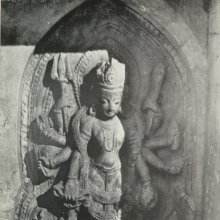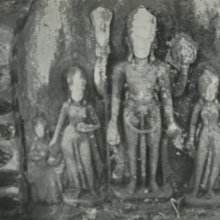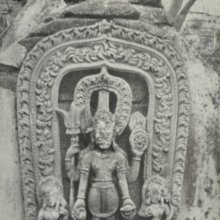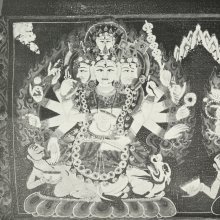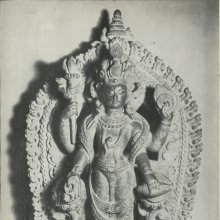Hara, Hāra: 45 definitions
Introduction:
Hara means something in Buddhism, Pali, Hinduism, Sanskrit, Jainism, Prakrit, the history of ancient India, Marathi, Hindi, biology. If you want to know the exact meaning, history, etymology or English translation of this term then check out the descriptions on this page. Add your comment or reference to a book if you want to contribute to this summary article.
Images (photo gallery)
(+9 more images available)
In Hinduism
Shilpashastra (iconography)
Source: Wisdom Library: Elements of Hindu IconograpyHara (हर):—Sixth of the eleven emanations of Rudra (ekādaśa-rudra), according to the Viśvakarma-śilpa. He keeps in his right hands the mudgara, ḍamaru, śūla, aṅkuśa, gadā, sarpa and akṣamālā, (the object in the remaining hand is not mentioned); and in the left hands, paṭṭiśa, tomara, śakti, paraśu, tarjanī, ghaṭa, khaṭvāṅga and paṭṭikā (?).
Source: Google Books: Elements of Hindu iconographyHāra (हार) means a necklace and is seen in many different patterns. In the earlier periods, it is somewhat short and forms a broad band made up of several pieces.
Source: Shodhganga: Vaisnava Agamas And Visnu ImagesHāra (हार) refers to a type of necklace or “neck-ornament” (kaṇṭhābhūṣaṇa), as defined in treatises such as the Pāñcarātra, Pādmasaṃhitā and Vaikhānasa-āgamas, extensively dealing with the technical features of temple art, iconography and architecture in Vaishnavism.—Hāra is a general term used to designate either a garland (invariably used just like the term mālā) or a long necklace with single or multiple strings or laces. They may be of pearls (muktāhāra) and of gems (ratnahāra), worn around the neck and generally falling over the breast to the sternum. In the icons of Government Museum, Chennai, one can notice the hāra extended to the level of kakṣasūtra.

Shilpashastra (शिल्पशास्त्र, śilpaśāstra) represents the ancient Indian science (shastra) of creative arts (shilpa) such as sculpture, iconography and painting. Closely related to Vastushastra (architecture), they often share the same literature.
Shaivism (Shaiva philosophy)
Source: Wisdom Library: ŚaivismHara (हर), one of the fifty Rudras according to the Caryāpāda section of the Makuṭāgama (one of the 28 Saiva Siddhanta Agamas).
Source: Wisdom Library: ŚaivismHara (हर) is the Sanskrit name of a deity presiding over Hariścandra, one of the sixty-eight places hosting a svāyambhuvaliṅga, which is one of the most sacred of liṅgas according to the Śaivāgamas. The list of sixty-eight svāyambhuvaliṅgas and presiding deities (e.g., Hara) is found in the commentary on the Jirṇoddhāra-daśaka by Nigamajñānadeva. The word liṅga refers to a symbol used in the worship of Śiva and is used thoughout Śaiva literature, such as the sacred Āgamas.
Source: Google Books: Manthanabhairavatantram (shaivism)Hāra (हार) refers to “necklaces”, according to the Śrīmatottara-tantra, an expansion of the Kubjikāmatatantra: the earliest popular and most authoritative Tantra of the Kubjikā cult. Accordingly, “O goddess, Svacchanda is in the middle, within the abode of the triangle. Very powerful, he has five faces with three times five flaming eyes. He has ten arms and, very fierce, is adorned with many garlands, ornaments, necklaces and anklets [i.e., hāra-nūpura-maṇḍita]. He has beautiful matted hair and the half moon is his crest jewel. O beloved, the face in the east is white like cow’s milk, it shines brilliant white. Generating great energy, contemplate it thus. One should think that the northern face is like the young rising sun, the form of a pomegranate flower and (red) like a Bandhūka”.
Source: Shodhganga: Iconographical representations of ŚivaHara (हर) is the name of a deity who received the Kāmikāgama from Trikala who in turn, received it from Praṇava through the mahānsambandha relation, according to the pratisaṃhitā theory of Āgama origin and relationship (sambandha). The kāmika-āgama, being part of the ten Śivabhedāgamas, refers to one of the twenty-eight Siddhāntāgamas: a classification of the Śaiva division of Śaivāgamas. The Śaivāgamas represent the wisdom that has come down from lord Śiva, received by Pārvatī and accepted by Viṣṇu.
Hara obtained the Kāmikāgama from Trikala who in turn obtained it from Praṇava who in turn obtained it from Sadāśiva through parasambandha. Hara then, through divya-sambandha transmitted it to the Devas who, through divyādivya-sambandha, transmitted it to the Ṛṣis who finally, through adivya-sambandha, revealed the Kāmikāgama to human beings (Manuṣya). (also see Anantaśambhu’s commentary on the Siddhāntasārāvali of Trilocanaśivācārya)
Source: SOAS University of London: Protective Rites in the Netra TantraHāra (हार) refers to a “garland” (of pearls), according to the Netratantra of Kṣemarāja: a Śaiva text from the 9th century in which Śiva (Bhairava) teaches Pārvatī topics such as metaphysics, cosmology, and soteriology.—Accordingly, [verse 3.17-23, while describing a meditation on Amṛteśa in his form as Mṛtyujit]—“And so now, having constructed the amṛtāmudrā or the padmamudrā, [the Mantrin] should meditate on the Ātman. [...] One should think of him [dressed in] white clothes and ornaments, [draped in] a radiant garland (śubhra-hāra) of pearls, bulbs like moonlight, etc. (śubhrahārendukandādi), his body is anointed with white sandalwood and dust-colored powdered camphor. In he middle of the somamaṇḍala, [he is] bathed in thick, abundant waves of amṛta [that make the] moon quiver. [...]”.

Shaiva (शैव, śaiva) or Shaivism (śaivism) represents a tradition of Hinduism worshiping Shiva as the supreme being. Closely related to Shaktism, Shaiva literature includes a range of scriptures, including Tantras, while the root of this tradition may be traced back to the ancient Vedas.
Purana and Itihasa (epic history)
Source: Wisdom Library: Agni PurāṇaHara (हर):—One of the Eleven Rudras (ekādaśa-rudra), according to the Agni-purāṇa. The Agni Purāṇa is a religious text containing details on Viṣṇu’s different incarnations (avatar), but also deals with various cultural subjects such as Cosmology, Grammar and Astrology.
Source: Google Books: Cultural History from the Vāyu PurānaHāra (हार)—One of the Heavenly ornaments according to the Vāyu Purāṇa. Used by the people of the Kuru land. The Śūras are called hārakāḥ.
Source: archive.org: Puranic Encyclopedia1) Hara (हर).—A famous Dānava, born to Kaśyapa of his wife Danū. He was reborn as King Subāhu. (Ādi Parva, Chapter 67, Verse 23).
2) Hara (हर).—One of the eleven Rudras. (Śānti Parva, Chapter 208, Verse 19).
3) Hara (हर).—A synonym of Śiva.
4) Hāra (हार).—A region of Purāṇic fame. Nakula subjugated the King of Hāra by a simple command without any resort to arms, and the King attended Yudhiṣṭhira’s Rājasūya with presents. (Sabhā Parva, Chapter 51, Verse 54).
Source: archive.org: Shiva Purana - English Translation1) Hara (हर) refers to one of the eight names of Śiva (śivanāma) and is mentioned in the Śivapurāṇa 1.20 while explaining the mode of worshipping an earthen phallic image (pārthiva-liṅga) according to the Vedic rites:—“[...] the eight names of Śiva viz:—Hara, Maheśvara, Śambhu, Śūlapāṇi, Pinākadhṛk, Śiva, Paśupati and Mahādeva shall be used respectively for the rites of bringing the clay, kneading, installation, invocation, ceremonial ablution, worship, craving the forbearance and ritualistic farewell. Each of the names shall be prefixed with Oṃkāra. The name shall be used in the dative case and Namaḥ shall be added to them. The rites shall be performed respectively with great devotion and joy. [...]”.
2) Hāra (हार) refers to “ornamental necklaces”, according to the Śivapurāṇa 2.3.40 (“The Marriage Procession of Śiva”).—Accordingly, as Brahmā narrated to Nārada: “[...] These and other leaders of Gaṇas of great strength and multitudinous in number joined the procession with joy and enthusiasm. They had a thousand hands. They wore matted hair and crowns. They were bedecked with streaks of the moon. They had three eyes and blue necks (like lord Śiva). All of them wore garlands of Rudrākṣa beads. They had the holy ashes smeared over the body. They had the ornaments of necklaces (hāra), earrings, bracelets, crowns etc. [...]”.
Source: Cologne Digital Sanskrit Dictionaries: The Purana Index1a) Hara (हर).—Also Kālarūpa.*
- * Brahmāṇḍa-purāṇa III. 7. 26; 23. 33; 24. 10; 25. 45; 26. 3; 32. 30; 38. 4; 73. 2.
1b) One of the eleven Rudras.*
- * Matsya-purāṇa 5. 29; Viṣṇu-purāṇa I. 15. 122.
1c) Śiva;1 with 18 hands;2 an ascetic according to Kaṃsa.3
Source: JatLand: List of Mahabharata people and placesHara (हर) is a name mentioned in the Mahābhārata (cf. I.61.24) and represents one of the many proper names used for people and places. Note: The Mahābhārata (mentioning Hara) is a Sanskrit epic poem consisting of 100,000 ślokas (metrical verses) and is over 2000 years old.

The Purana (पुराण, purāṇas) refers to Sanskrit literature preserving ancient India’s vast cultural history, including historical legends, religious ceremonies, various arts and sciences. The eighteen mahapuranas total over 400,000 shlokas (metrical couplets) and date to at least several centuries BCE.
Natyashastra (theatrics and dramaturgy)
Source: Wisdom Library: Nāṭya-śāstra1) Hara (हर) is a Sanskrit word referring to Śiva. Acording to the Nāṭyaśāstra 1.88-95, when Brahmā, Indra and all other gods went to inspect the playhouse (nāṭyamaṇḍapa) designed by Viśvakarmā, he assigned different deities for the protection of the playhouse itself, as well as for the objects relating to dramatic performance (prayoga).
As such, Brahmā assigned Hara to the remaining characters (eg., excluding the hero, heroine and jester). The protection of the playhouse was enacted because of the jealous Vighnas (malevolent spirits), who began to create terror for the actors.
2) Hāra (हार) refers to “necklaces” and is classified as āropya, or “ ornaments that to be put round”, according to Nāṭyaśāstra chapter 23. Āropya is one of the four types of ornaments (ābharaṇa).
Ābharaṇa (‘ornaments’, eg., hāra) is a category of alaṃkāra, or “decorations”, which in turn is a category of nepathya, or “costumes and make-up”, the perfection of which forms the main concern of the Āhāryābhinaya, or “extraneous representation”, a critical component for a successful dramatic play.

Natyashastra (नाट्यशास्त्र, nāṭyaśāstra) refers to both the ancient Indian tradition (shastra) of performing arts, (natya—theatrics, drama, dance, music), as well as the name of a Sanskrit work dealing with these subjects. It also teaches the rules for composing Dramatic plays (nataka), construction and performance of Theater, and Poetic works (kavya).
Shaktism (Shakta philosophy)
Source: Google Books: ManthanabhairavatantramHarā (हरा) refers to “she who removes (impurities that sully the Rule)”, according to the Manthānabhairavatantra, a vast sprawling work that belongs to a corpus of Tantric texts concerned with the worship of the goddess Kubjikā.—Accordingly, “[...] Active in the utterance (of mantra that takes place) in the centre, she pervades all things with the mass of (her) red and beautiful rays. (She is) the threefold Nityaklinnā, the universal energy of Śiva, the root goddess who pervades (all things). She awakens the Command that has been destroyed and removes the impurities (that sully the) Rule (samayamala-harā). She alone is capable of piercing the bridge. She is the garland of thirty-two syllables, the awakened Kaulika Command, the supreme energy (well) deployed. Pure, she is the Light of the Void and she pulses radiantly with waves of rays. She alone conjoins (the fettered to) the path of the Siddhas. [...]”.
Source: Shodhganga: Iconographical representations of Śiva (shaktism)Hara (हर) or Haratantra refers to one of the twenty-eight Gāruḍatantras, belonging to the Śāktāgama (or Śāktatantra) division of the Āgama tradition. The Śāktāgamas represent the wisdom imparted by Devī to Īśvara and convey the idea that the worship of Śakti is the means to attain liberation. According to the Pratiṣṭhālakṣaṇasamuccaya of Vairocana, the Śāktatantras are divided into to four parts, the Hara belonging to the Garuḍa class.
Source: Brill: Śaivism and the Tantric Traditions (shaktism)Hāra (हार) refers to “necklaces”, according to the King Vatsarāja’s Pūjāstuti called the Kāmasiddhistuti (also Vāmakeśvarīstuti), guiding one through the worship of the Goddess Nityā.—Accordingly, “[...] She has braided hair. Her limbs are adorned with bracelets, earrings, necklaces (hāra), twining laces, girdles, jewels, and anklets. Her clothes resemble Bandhūka flowers. She is full of affection, and the hue of her body is brightened up with saffron and sandal paste.. [...]”.

Shakta (शाक्त, śākta) or Shaktism (śāktism) represents a tradition of Hinduism where the Goddess (Devi) is revered and worshipped. Shakta literature includes a range of scriptures, including various Agamas and Tantras, although its roots may be traced back to the Vedas.
Ayurveda (science of life)
Source: archive.org: Vagbhata’s Ashtanga Hridaya Samhita (first 5 chapters)Hāra (हार) refers to a “string of pearls”, mentioned in verse 3.40 of the Aṣṭāṅgahṛdayasaṃhitā (Sūtrasthāna) by Vāgbhaṭa.—Accordingly, “from him whose mind is at ease, (who is) moist with sandal [...]—wreaths of camphor and of jasmine; strings of pearls [viz., hāra] furnished with yellow sandal ; young thrushes (and) parrots whose chatter is lovely and sweet; (and)[...]”.
Note: Hara (“string of pearls”) has been rendered mu-tig do-śal (“pearl-necklace”), while its adjunct saharicandana (“furnished with yellow sandal”) has been turned tsan-dan dkar (“white with sandal”). On tsan-dan and tsandan see v. 20.

Āyurveda (आयुर्वेद, ayurveda) is a branch of Indian science dealing with medicine, herbalism, taxology, anatomy, surgery, alchemy and related topics. Traditional practice of Āyurveda in ancient India dates back to at least the first millenium BC. Literature is commonly written in Sanskrit using various poetic metres.
Vastushastra (architecture)
Source: OpenEdition books: Architectural terms contained in Ajitāgama and RauravāgamaHāra (हार) refers to “wall bordering an ambulatory outside §§ 4.8, 10.”.—(For paragraphs cf. Les enseignements architecturaux de l'Ajitāgama et du Rauravāgama by Bruno Dagens)

Vastushastra (वास्तुशास्त्र, vāstuśāstra) refers to the ancient Indian science (shastra) of architecture (vastu), dealing with topics such architecture, sculpture, town-building, fort building and various other constructions. Vastu also deals with the philosophy of the architectural relation with the cosmic universe.
Ganitashastra (Mathematics and Algebra)
Source: archive.org: Hindu Mathematics1) Hara (हर) represents the number 11 (eleven) in the “word-numeral system” (bhūtasaṃkhyā), which was used in Sanskrit texts dealing with astronomy, mathematics, metrics, as well as in the dates of inscriptions and manuscripts in ancient Indian literature.—A system of expressing numbers by means of words arranged as in the place-value notation was developed and perfected in India in the early centuries of the Christian era. In this system the numerals [e.g., 11—hara] are expressed by names of things, beings or concepts, which, naturally or in accordance with the teaching of the Śāstras, connote numbers.
2) Hara (हर) refers to the “divisor” in bhāgahāra (“division”), which refers to one of the twenty operations (logistics) of pāṭīgaṇita (“science of calculation which requires the use of writing material—the board”), according to Pṛthudakasvāmī’s commentary on the Brāhmasphuṭasiddhānta by Brahmagupta, a Sanskrit treatise on ancient Indian mathematics (gaṇita-śāstra) and astronomy from the 7th century.—The common Hindu names for the operation are bhāgahāra, bhājana, haraṇa, chedana, etc. All these terms literally mean “to break into parts”, i.e., “to divide”, excepting haraṇa which denotes “to take away”. This term shows the relation of division to subtraction. The dividend is termed bhājya, hārya, etc., the divisor bhājaka, bhāgahara or simply hara, and the quotient labdhi “what is obtained” or labdha.

Ganitashastra (शिल्पशास्त्र, gaṇitaśāstra) refers to the ancient Indian science of mathematics, algebra, number theory, arithmetic, etc. Closely allied with astronomy, both were commonly taught and studied in universities, even since the 1st millennium BCE. Ganita-shastra also includes ritualistic math-books such as the Shulba-sutras.
In Buddhism
Tibetan Buddhism (Vajrayana or tantric Buddhism)
Source: OSU Press: Cakrasamvara SamadhiHara (हर) refers to “removing (darkness and fear)”, according to the Guru Mandala Worship (maṇḍalārcana) ritual often performed in combination with the Cakrasaṃvara Samādhi, which refers to the primary pūjā and sādhanā practice of Newah Mahāyāna-Vajrayāna Buddhists in Nepal.—Accordingly, “In praise (of) Śrī Vajrasattva, highest universal guru, origin of all Buddhas, By various forms, removing darkness and fear [e.g., timira-bhaya-haraṃ], fixed resting on Meru. Dharma sustainer, chief sage, most fortunate victor, Vajradhātu mandala, In one form with all bliss, innate bliss, embodied, the cause for liberation”.
Source: MDPI Books: The Ocean of HeroesHāra (हार) refers to “garlands” (of pearls), according to the 10th-century Ḍākārṇava-tantra: one of the last Tibetan Tantric scriptures belonging to the Buddhist Saṃvara tradition consisting of 51 chapters.—Accordingly, [while describing the Merit Circle (guṇacakra)]: “[...] He should make [mantras of all Yoginīs] on all circles [in this manner]. Outside that, he should give a circle, [on which there are] two lines [colored] black and dark blue. Gates, arched doorways, and altars are [on the circle], adorned with garlands (hāra) of pearls and half-garlands of pearls. [...] Two colors should be evenly assigned [to them] in accordance with the [directions they] face, respectively. [...]”.

Tibetan Buddhism includes schools such as Nyingma, Kadampa, Kagyu and Gelug. Their primary canon of literature is divided in two broad categories: The Kangyur, which consists of Buddha’s words, and the Tengyur, which includes commentaries from various sources. Esotericism and tantra techniques (vajrayāna) are collected indepently.
In Jainism
General definition (in Jainism)
Source: Wisdom Library: JainismHāra (हार) is the shorter name of Hāradvīpa, one of the continents (dvīpa) of the middle-world (madhyaloka) which is encircled by the ocean named Hārasamudra (or simply Hāra), according to Jain cosmology. The middle-world contains innumerable concentric dvīpas and, as opposed to the upper-world (adhaloka) and the lower-world (ūrdhvaloka), is the only world where humans can be born.
Hāra is recorded in ancient Jaina canonical texts dealing with cosmology and geography of the universe. Examples of such texts are the Saṃgrahaṇīratna in the Śvetāmbara tradition or the Tiloyapannatti and the Trilokasāra in the Digambara tradition.
Source: archive.org: The Jaina IconographyHāra (हार) is a combination of 18 strings of jewels (The Antagaḍa-Dasāo and Aṇuttarovavāiya-Dasāo Oriental Translation Fund, p. 21).

Jainism is an Indian religion of Dharma whose doctrine revolves around harmlessness (ahimsa) towards every living being. The two major branches (Digambara and Svetambara) of Jainism stimulate self-control (or, shramana, ‘self-reliance’) and spiritual development through a path of peace for the soul to progess to the ultimate goal.
India history and geography
Source: Shodhganga: A study of place names of Nalgonda districtHara or Ahara is one of the terms designating an ‘administrative division’ used in the inscriptions of Andhra Pradesh.—In the inscriptions of Andhra Pradesh the term ahara is not met with, instead hara is used. The earliest occurrence is Satavahani-hara which is also the earliest administrative unit mentioned in the inscriptions of region. In the succeeding period the Salankayanas and the Brihatphalayanas continued to use the same hara appellation, e.g., Kudra-hara or Kudura-hara. The Eastern Chalukyas from the seventh to the nineth century used hara as an integral part, not as a suffix of the unit, e.g., Gudrahara-Vishaya. Ahara occurs as a divisional appellation in the inscriptions of Gujarat (Kapur-ahara), of Maharashtra (Govardhana-ahara) and in the North-Konkan (Ikharaki-ahara).
Source: Cologne Digital Sanskrit Dictionaries: Indian Epigraphical GlossaryHara.—(IE 7-1-2), ‘eleven’. Note: hara is defined in the “Indian epigraphical glossary” as it can be found on ancient inscriptions commonly written in Sanskrit, Prakrit or Dravidian languages.

The history of India traces the identification of countries, villages, towns and other regions of India, as well as mythology, zoology, royal dynasties, rulers, tribes, local festivities and traditions and regional languages. Ancient India enjoyed religious freedom and encourages the path of Dharma, a concept common to Buddhism, Hinduism, and Jainism.
Biology (plants and animals)
Source: Wisdom Library: Local Names of Plants and DrugsHara in the Kannada language is the name of a plant identified with Excoecaria agallocha L. from the Euphorbiaceae (Castor) family. For the possible medicinal usage of hara, you can check this page for potential sources and references, although be aware that any some or none of the side-effects may not be mentioned here, wether they be harmful or beneficial to health.
Source: Google Books: CRC World Dictionary (Regional names)Hara in Philippines is the name of a plant defined with Leea aculeata in various botanical sources. This page contains potential references in Ayurveda, modern medicine, and other folk traditions or local practices It has the synonym Ticorea aculeata Blanco (among others).
Example references for further research on medicinal uses or toxicity (see latin names for full list):
· Bijdr. Fl. Ned. Ind. (1825)
· Annales Museum Botanicum Lugduno-Batavi (1863)
· Flora de Filipinas (1845)
· Bulletin of Miscellaneous Information Kew (1931)
· Flora de Filipinas (1837)
· Systema Vegetabilium (1824)
If you are looking for specific details regarding Hara, for example chemical composition, side effects, diet and recipes, pregnancy safety, health benefits, extract dosage, have a look at these references.

This sections includes definitions from the five kingdoms of living things: Animals, Plants, Fungi, Protists and Monera. It will include both the official binomial nomenclature (scientific names usually in Latin) as well as regional spellings and variants.
Languages of India and abroad
Pali-English dictionary
Source: BuddhaSasana: Concise Pali-English Dictionaryhara : (m.) the God Isvara. || hāra (m.), a string (of pearls, etc.); a necklace.
Source: Sutta: The Pali Text Society's Pali-English DictionaryHara, (adj.) (-°) (fr. hṛ) taking, fetching; vayo° bringing age (said of grey hairs) J.I, 138; du° S.I, 36. (Page 729)
— or —
Hāra, (fr. harati) 1. that which may be taken; grasping, taking; grasp, handful, booty. In cpd. °hārin taking all that can be taken, rapacious, ravaging J.VI, 581 (of an army; Kern, Toev. I.133 wrong in translation “magnificent, or something like it”). Of a river: tearing, rapid A.III, 64; IV, 137; Vism.231.—2. category; name of the first sections of the Netti Pakaraṇa Nett 1 sq., 195. (Page 731)

Pali is the language of the Tipiṭaka, which is the sacred canon of Theravāda Buddhism and contains much of the Buddha’s speech. Closeley related to Sanskrit, both languages are used interchangeably between religions.
Marathi-English dictionary
Source: DDSA: The Molesworth Marathi and English Dictionaryhara (हर).—m (S) A name of Shiva or Mahadeva.
--- OR ---
hara (हर).—a S That seizes, takes away, carries off. In comp as dhanahara, kīrttihara, sukhahara, duḥkhahara, yaśōhara, kaphahara, pittahara, vātahara, jvarahara Thief, robber, rogue &c. 2 In arithmetic. That divides, the divisor: also the denominator of a fraction.
--- OR ---
hara (हर).—a ( P) Every. Used freely with words; as hara ghaḍī, hara vakhata, hara rastā, hara gāṃva, hara jāgā &c. In some of the instances of the use of this word the sense seems to be slightly different from that given here. Such instances will be found in their order.
--- OR ---
hara (हर).—&c. See hāra, hārajīta &c. Note. Of some of the compounds or derivatives of hāra Loss or Line (e. g. haraṇēṃ, harapaṇēṃ, haraviṇēṃ, harīṃ, harēmōharēsa, harōhara) the preferable form is hara whilst of others it is hāra; but as the preferableness is in different localities differently determined, notice, greater or less, is taken of both forms.
--- OR ---
harā (हरा).—m A large basket of a particular form and of loose texture. Pr. vāḷakācā harā āṇi tākācā ḍērā (phāra divasa rāhata nāhīṃ); or harā vārā dēvhārā tākācā ḍērā (dōna divasācā). The figure of these four perishable or ephemeral things is significant of Transitoriness. harā (Basket) is here taken for Basket-full of watermelons or fruits.
--- OR ---
hāra (हार).—m (S) A necklace; a garland or wreath; a string (of gems, beads, flowers &c.) 2 f A line or row.
--- OR ---
hāra (हार).—f (S Taking, or hṛ To seize.) Loss. v yē, basa. 2 Defeat (in battle, gambling &c.) v yē. 3 m Taking from, seizing, robbing, rape. 4 In arithmetic. Divisor. hāra khāṇēṃ -ghēṇēṃ and, with direct or inverse construction, -jāṇēṃ To sustain loss or defeat, to lose. hāra jāṇēṃ with direct construction and dat. of o. is To allow or to undergo defeat by or inferiority unto. hāra ghēṇēṃ -patakaraṇēṃ -mānaṇēṃ To accept or agree to loss. Pr. hāra mānalī jhagaḍā tuṭalā; also hāra mānalī paṇa jhagaḍā tuṭō Peace! peace! peace upon any sacrifice or concession. hārīṃ jāṇēṃ with dat. of o. To succumb or dub unto; to acknowledge defeat by.
--- OR ---
hārā (हारा).—m (Or harā) A large basket made of bamboo slips.
Source: DDSA: The Aryabhusan school dictionary, Marathi-Englishhara (हर).—a Every. That takes away. m A name of śiva.
--- OR ---
harā (हरा).—m A large basket of a particular form and of loose texture.
--- OR ---
hāra (हार).—m A necklace; a garland. f A row. Loss. Defeat. Robbing. Divisor (in arithmetic). hāra ghēṇēṃ-patakaraṇēṃ-mānaṇēṃ Accept or agree to loss. hārīṃ jāṇēṃ Succumb. hāra khāṇēṃ-ghēṇēṃ-jāṇēṃ To sustain defeat.
--- OR ---
hārā (हारा).—m A large basket made of bamboo slips.
Marathi is an Indo-European language having over 70 million native speakers people in (predominantly) Maharashtra India. Marathi, like many other Indo-Aryan languages, evolved from early forms of Prakrit, which itself is a subset of Sanskrit, one of the most ancient languages of the world.
Sanskrit dictionary
Source: DDSA: The practical Sanskrit-English dictionaryHara (हर).—a. (-rā, -rī f.) [हृ-अच् (hṛ-ac)]
1) Taking away, removing, depriving one of; as in खेदहर, शोकहर (khedahara, śokahara).
2) Bringing, conveying, carrying, taking; अपथहराः (apathaharāḥ) Kirātārjunīya 5.5; R.12.51.
3) Seizing, grasping.
4) Attracting, captivating.
5) Claiming, entitled to; as in रिक्थहर (rikthahara) &c.; परिहृतमयशः पातितमस्मासु च घातितोऽर्धराज्यहरः (parihṛtamayaśaḥ pātitamasmāsu ca ghātito'rdharājyaharaḥ) Mu.2.19.
6) Occupying; समादिदेशैकवधूं भवित्रीं प्रेम्णा शरीरार्धहरां हरस्य (samādideśaikavadhūṃ bhavitrīṃ premṇā śarīrārdhaharāṃ harasya) Kumārasambhava 1.5.
7) Dividing.
-raḥ 1 Śiva; श्रुताप्सरोगीतिरपि क्षणेऽस्मिन् हरः प्रसं- ख्यानपरो बभूव (śrutāpsarogītirapi kṣaṇe'smin haraḥ prasaṃ- khyānaparo babhūva) Kumārasambhava 3.4,67;1.5; Meghadūta 7.
2) Name of Agni or fire.
3) An ass.
4) A divisor.
5) The denominator of a fraction.
6) The act of seizing, taking.
7) A seizer, ravisher.
--- OR ---
Hāra (हार).—[hṛ-karmaṇi ghañ]
1) Taking away, removal, seizing.
2) Conveying.
3) Abstraction, deprivation.
4) A carrier, porter.
5) A garland or necklace of pearls &c.; a necklace in general; हारोऽयं हरिणाक्षीणां लुठति स्तन- मण्डले (hāro'yaṃ hariṇākṣīṇāṃ luṭhati stana- maṇḍale) Amaruśataka 1; पाण्ड्योऽयमंसार्पितलम्बहारः (pāṇḍyo'yamaṃsārpitalambahāraḥ) R.6.6;5.52; 6.16; Meghadūta 74; Ṛtusaṃhāra 1.4;2.18.
6) War, battle.
7) (In math.) The denominator of a fraction.
8) A divisor.
9) (In prosody) A long syllable.
Derivable forms: hāraḥ (हारः).
Source: Cologne Digital Sanskrit Dictionaries: Shabda-Sagara Sanskrit-English DictionaryHara (हर).—mfn. (raḥ-rā or -rī-raṃ) Who or what takes or seizes, carries or conveys, divides, removes, &c. m.
(-raḥ) 1. Siva. 2. Agni. 3. An ass. 4. (In Arithmetic,) A divisor; also the denominator of a fraction. E. hṛ to take, aff. ap, ac or ṭac.
--- OR ---
Hāra (हार).—mfn.
(-raḥ-rī-raṃ) Who or what takes, &c. m.
(-raḥ) 1. A porter, a carrier. 2. Taking, conveying. 3. Abstraction, deprivation. 4. A necklace, a string of pearls, &c. 5. War, battle. 6. (In prosody,) A long syllable. 7. (In Arithmetic,) A divisor, also the denominator of a fraction. E. hṛ to seize, (the mind, &c.,) and ghañ aff., or causal form, with aṇ aff.
Source: Cologne Digital Sanskrit Dictionaries: Benfey Sanskrit-English DictionaryHara (हर).—i. e. hṛ + a, I. adj. Taking, [Pañcatantra] i. [distich] 278; seizing, carrying, [Kirātārjunīya] 5, 50; depriving of (vibhrama-, surpassing the beauty), [Bhartṛhari, (ed. Bohlen.)] 1, 5. Ii. m. 1. Śiva, [Vikramorvaśī, (ed. Bollensen.)] [distich] 48. 2. Agni. 3. An ass (cf. khara).
--- OR ---
Hāra (हार).—i. e. partly hri + a, I. adj. Who or what takes. Ii. m. 1. Taking. 2. A porter. 3. A string of pearls, [Pañcatantra] 52, 22; 53, 1. 4. War, battle.
Source: Cologne Digital Sanskrit Dictionaries: Cappeller Sanskrit-English DictionaryHara (हर).—(only —°, [feminine] ā, [rarely] ī) carrying, bringing; taking, receiving, seizing, robbing; ravishing, charming; removing, destroying. [masculine] seizer or destroyer, [Epithet] of Śiva, a man’s name.
--- OR ---
Hāra (हार).—[feminine] ī carrying, bringing, taking, seizing, ravishing, charming (—°). [masculine] a string or garland of pearls (adj. —° [feminine] ā); taking away, removing, deprivation, loss.
Source: Cologne Digital Sanskrit Dictionaries: Aufrecht Catalogus Catalogorum1) Hara (हर) as mentioned in Aufrecht’s Catalogus Catalogorum:—poet. Padyāvalī.
2) Hara (हर):—Āśaucadaśakaṭīka.
Source: Cologne Digital Sanskrit Dictionaries: Monier-Williams Sanskrit-English Dictionary1) Hara (हर):—a mf(ā, rarely ī)n. (only ifc.; [from] √1. hṛ) bearing, wearing, taking, conveying, bringing (See kavaca-, vārttā-h), taking away, carrying off, removing, destroying (See bala-, śakti-h)
2) receiving, obtaining (See aṃśa-h)
3) ravishing, captivating (See mano-h)
4) m. ‘Seizer’, ‘Destroyer’, Name of Śiva, [Āśvalāyana-gṛhya-sūtra; Manu-smṛti; Mahābhārata] etc.
5) of a Dānava, [Mahābhārata; Harivaṃśa]
6) of a monkey, [Rāmāyaṇa]
7) of various authors etc., [Catalogue(s)]
8) (in [arithmetic]) a divisor, [Colebrooke]
9) the denominator of a fraction, division, [ib.]
10) a stallion (?), [cf. Lexicographers, esp. such as amarasiṃha, halāyudha, hemacandra, etc.]
11) an ass, [cf. Lexicographers, esp. such as amarasiṃha, halāyudha, hemacandra, etc.]
12) fire, [cf. Lexicographers, esp. such as amarasiṃha, halāyudha, hemacandra, etc.]
13) Hāra (हार):—[from hara] 1. hāra mf(ī)n. bearing, carrying, carrying away, stealing (e.g. kṣīra-h, ‘stealing milk’), [Mārkaṇḍeya-purāṇa]
14) [v.s. ...] levying, raising (e.g. kara-h, ‘raising taxes’), [Bhāgavata-purāṇa]
15) [v.s. ...] ravishing, charming, delightful (or ‘relating to Hari id est. Viṣṇu’), [ib.]
16) [v.s. ...] relating to Hara or Śiva, [Nalacampū or damayantīkathā]
17) [v.s. ...] m. taking away, removal, [ib.]
18) [v.s. ...] confiscation, forfeiture (of land, money etc.), [Manu-smṛti; Mahābhārata; Kathāsaritsāgara]
19) [v.s. ...] waste, loss (See kāla-h)
20) [v.s. ...] war, battle, [Horace H. Wilson]
21) [v.s. ...] a carrier, porter, [ib.]
22) [v.s. ...] (in [arithmetic]) a divisor or division, [Colebrooke]
23) [v.s. ...] (in prosody) a long syllable, [ib.]
24) [v.s. ...] a garland of pearls, necklace ([according to] to some, one of 108 or 64 strings), [Mahābhārata; Kāvya literature] etc.
25) Hārā (हारा):—[from hāra > hara] f., [Pāṇini 3-3, 104]
26) Hāra (हार):—[from hara] 2. hāra (for 3. See p. 1292, col. 1) [Nominal verb] [Parasmaipada] rati to be like a string of pearls, [Dhūrtasamāgama]
27) [from hari] 3. hāra mfn. (for 1. and 2. See p. 1289, col. 2) relating to Hari or Viṣṇu, [Bhāgavata-purāṇa]
28) a hāraka, hārin etc. See p.1289, [columns] 2 and 3.
29) Hara (हर):—[from hṛ] b etc. See p.1289.
Source: Cologne Digital Sanskrit Dictionaries: Yates Sanskrit-English Dictionary1) Hara (हर):—(raḥ) 1. m. Shiva; Agni; an ass; (in arith.) division. a. One who takes or seizes.
2) Hāra (हार):—(raḥ) 1. m. A string or garland of pearls; war; a porter; taking; a divisor. a. Taking.
Source: DDSA: Paia-sadda-mahannavo; a comprehensive Prakrit Hindi dictionary (S)Hara (हर) in the Sanskrit language is related to the Prakrit words: Hara, Hāra.
[Sanskrit to German]
Sanskrit, also spelled संस्कृतम् (saṃskṛtam), is an ancient language of India commonly seen as the grandmother of the Indo-European language family (even English!). Closely allied with Prakrit and Pali, Sanskrit is more exhaustive in both grammar and terms and has the most extensive collection of literature in the world, greatly surpassing its sister-languages Greek and Latin.
Hindi dictionary
Source: DDSA: A practical Hindi-English dictionary1) Hara (हर) [Also spelled har]:—(a) each, every; (nm) a denominator; Lord Shiv; a suffix imparting the meaning of one who or that which takes away/deprives/seizes; —[eka] everyone, each and every; —[kahīṃ] everywhere; —[koī] every one all and sundry; ~[caṃda] however much; ~[jāī] flirt, disloyal (woman); —[taraha] in every way/manner; —[taraha se] down to the ground, in all respects, thoroughly; ~[dama] always, ever; ~[dila ajīja] liked/loved by all, popular; ~[phanamaulā] a jack of all trades; ~[phanamaulā hara phana adhūrā] jack of all trades master of none; —[marja kī davā] heal-all, a panacea; —[roja] every day, daily.
2) Harā (हरा):—(a) green, verdant; fresh; gay, delighted; ~[pana] greenness; verdancy; hence [harī] (fem. form); •[khāda] green manure; -[bharā] verdant; prosperous, flourishing; gay; —[karanā, (mana)] to delight; —[honā, (mana]) to be delighted, to be gay.
3) Hāra (हार) [Also spelled har]:—(nf) defeat; loss; a garland, necklace; a suffix meaning one who or that which carries away per force or usurps, charms, etc; or denotes a doer (as [sirajanahāra);-jīta] defeat and victory; —[khānā] to suffer a defeat; -[denā] to inflict a defeat; —[na mānanā] never say die, not to give in; —[mānanā] to cry enough, to acknowledge defeat, to concede supremacy.
4) Hārā (हारा):——a suffix carrying the sense of a doer (as [sirajanahārā]); (a and v) defeated; —[huā juārī] lit. a defeated gambler a man in a completely reticent unresponsive state of mind, frustrated and lost (man).
...
Prakrit-English dictionary
Source: DDSA: Paia-sadda-mahannavo; a comprehensive Prakrit Hindi dictionary1) Hara (हर) in the Prakrit language is related to the Sanskrit word: Grah.
2) Hara (हर) also relates to the Sanskrit word: Hṛd.
3) Hara (हर) also relates to the Sanskrit word: Hara.
4) Hara (हर) also relates to the Sanskrit word: Hrada.
5) Hara (हर) also relates to the Sanskrit word: Hara.
6) Hara (हर) also relates to the Sanskrit word: Dhara.
7) Hāra (हार) also relates to the Sanskrit word: Hāra.
8) Hāra (हार) also relates to the Sanskrit word: Hāra.
Prakrit is an ancient language closely associated with both Pali and Sanskrit. Jain literature is often composed in this language or sub-dialects, such as the Agamas and their commentaries which are written in Ardhamagadhi and Maharashtri Prakrit. The earliest extant texts can be dated to as early as the 4th century BCE although core portions might be older.
Kannada-English dictionary
Source: Alar: Kannada-English corpusHara (ಹರ):—
1) [noun] Śiva, one of the three main Gods of Hinduism.
2) [noun] fire.
3) [noun] the direction halfway between north and west; northwest.
4) [noun] (math.) the number by which another number is divided to get the quotient; divisor.
5) [noun] (math.) the mathematical process of dividing one quantity by another to find the quotient.
6) [noun] the termination of a disease or eradication of an evil.
7) [noun] an ass; a donkey.
8) [noun] a controlling (another person or another’s affairs).
9) [noun] (pros.) the sing (-) for a long syllable.
10) [noun] (math.) a symbol for the number eleven.
--- OR ---
Hāra (ಹಾರ):—[noun] food, esp. offered to a deity or demon.
--- OR ---
Hāra (ಹಾರ):—
1) [noun] a string of pearls; a necklace of sixty four or hundred and eight strings.
2) [noun] that which is charming, lovely.
3) [noun] the act of robbing or stealing.
4) [noun] (math.) the term below or to the right of the line in a fraction; the divisor of the numerator; denoinator.
--- OR ---
Hāra (ಹಾರ):—
1) [noun] a two-wheeled, usu. bullock drawn vehicle; a cart.
2) [noun] the fact that something can be done, got, mastered, endured etc. with ease; easiness.
Kannada is a Dravidian language (as opposed to the Indo-European language family) mainly spoken in the southwestern region of India.
See also (Relevant definitions)
Starts with (+507): Hairanagollu, Hara dhania, Hara dhanya, Hara Hara Mahadeva, Hara mekke kaayi, Hara muni, Hara nikhada, Hara-chirayata, Hara-ghunuca, Hara-gulab, Hara-mekki-kaui, Hara-mekki-kayi, Hara-nayana, Haraa, Haraai, Harababi, Harabahana, Harabakhata, Harabala, Harabange.
Ends with (+4388): Aandhi jhara, Abahvakshara, Abakhara, Abbhavahara, Abbhuddhara, Abhadra-vyavahara, Abhara, Abhaya Vihara, Abhayadhara, Abhayagirivihara, Abhibhara, Abhichara, Abhidhara, Abhighara, Abhihara, Abhinihara, Abhinirhara, Abhiparihara, Abhisamhara, Abhisankhara.
Full-text (+1273): Bharahara, Angahara, Haram, Harahara, Haras, Hura, Pragrahara, Harayashti, Ahara, Granthihara, Smarahara, Kshatahara, Harashaya, Haravati, Bhagahara, Uruhara, Suvidalla, Samdeshahara, Pretahara, Hari.
Relevant text
Search found 151 books and stories containing Hara, Hāra, Harā, Hārā, Haara; (plurals include: Haras, Hāras, Harās, Hārās, Haaras). You can also click to the full overview containing English textual excerpts. Below are direct links for the most relevant articles:
Garga Samhita (English) (by Danavir Goswami)
Verses 2.18.20-21 < [Chapter 18 - The Sight of Śrī Kṛṣṇacandra]
Verse 1.6.46 < [Chapter 6 - Description of Kaṃsa’s Strength]
Verse 2.20.7 < [Chapter 20 - The Rāsa-dance Pastime]
Bhakti-rasamrta-sindhu (by Śrīla Rūpa Gosvāmī)
Verse 2.4.33 < [Part 4 - Transient Ecstatic Disturbances (vyābhicāri-bhāva)]
Verse 2.1.360 < [Part 1 - Ecstatic Excitants (vibhāva)]
Verse 2.4.243 < [Part 4 - Transient Ecstatic Disturbances (vyābhicāri-bhāva)]
Sahitya-kaumudi by Baladeva Vidyabhushana (by Gaurapada Dāsa)
Text 9.43 [necklace diagram] < [Chapter 9 - Ornaments of Sound]
Text 9.9 < [Chapter 9 - Ornaments of Sound]
Text 9.32 < [Chapter 9 - Ornaments of Sound]
Kashyapa Shilpa-shastra (study) (by K. Vidyuta)
5. Measurement for the Storeys of the Gopuras < [Chapter 5 - Gopura Lakṣaṇa]
1. Conclusion (Prākāras) < [Chapter 6 - Conclusion]
4 (b). Technical terms for the component parts of the temple < [Chapter 2 - Author and his Works]
Chandogya Upanishad (Madhva commentary) (by Srisa Chandra Vasu)
Related products
(+2 more products available)
